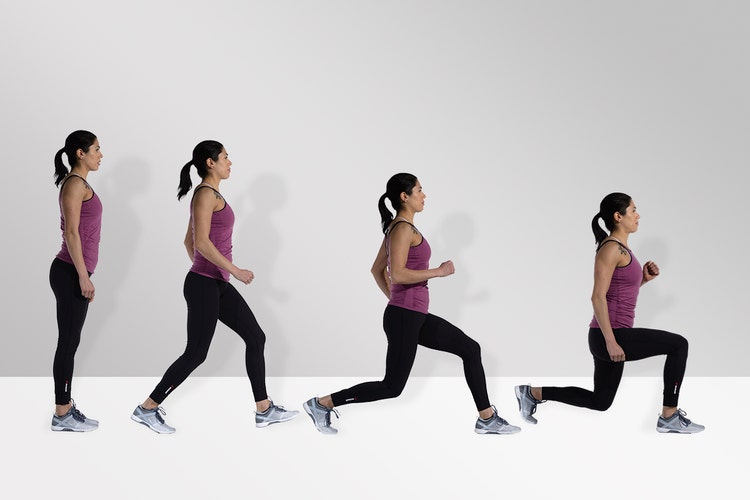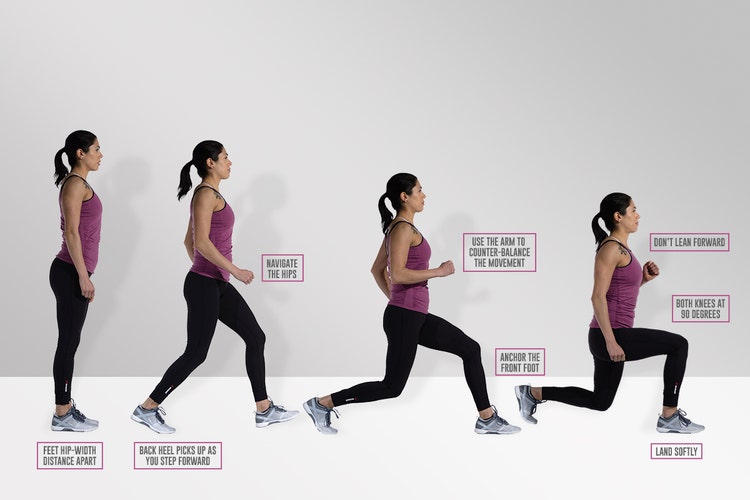Master this Move: Lunge

When it comes to shaping your legs and posterior, the squat isn’t the only exercise in town. Lunges work your entire lower body and posterior chain—including your hips, glutes, quads, inner thighs, hamstrings and even your core. Lunges are a compound move challenging several muscles at once, which is great for calorie burn and EPOC (excess post-exercise oxygen consumption), meaning you’ll continue to burn calories after your workout.

Things to keep in mind
Whether you are doing forward, backward, side, rotational or any other type of lunge, you are looking to achieve two major things: symmetry and timing.
Keep your lunge even on both sides and your movement as smooth as possible. If you’re not sure, you can accomplish both by regressing the range of motion and beginning with the direction in which you are confident.
Use the visual of a kite to maintain your form. Imagine your head is the north point and your coccyx (the bottom of your tailbone) is the south point of the kite. Your left shoulder is the west and right shoulder is the east. The kite works only when both axes are straight. This is even more important when you are lunging with a dumbbell or kettlebell. Keep your spine long and shoulders wide to achieve “kite” posture.
In addition to these coaching cues, every version of lunge has these three crucial components.
The feet
Your feet are two of the most important parts of your body in lunging well. Your stepping foot should safely find the ground and confidently anchor to finish the move. The interaction with the ground is important for engaging the right muscles in this move.
Your stationary foot either stays on the ground from heel to toe, or your heel lifts up (in the case of forward and backward lunges). Either way, your feet play a big role in stability and control.
Landing
In any type of lunge, the landing phase has to be controlled and safe. This is achieved by trusting and navigating with your hips. As soon as you hit the ground your legs triple flex: Your ankle, knee and hip will soften and bend so you can safely decelerate the move. This change also helps maintain kite posture as described above.
Integration
Like any other compound movement, it is better to use the entire body. Imagine how you walk: When you take a step with your left leg, your right arm swings forward. If you lunge with your right leg, your left arm comes up for counterbalance. This helps with timing and coordination. The human body is more efficient when its parts work together, and the lunge is definitely a move that proves this.
Things to avoid
Try to soften into your landing instead of holding a rigid posture. If your landing is rigid, all of your bodyweight will dissipate into your joints instead of your muscles and fascia.
Beginner movement If you are new to lunges, the supported lunge can be a great move for gaining confidence and some necessary strength in your legs. You can use a door frame or suspension trainer to make things easier at the start.
Advanced movement Power is a vital component of life and sport performance, so it’s hugely beneficial to add plyometric lunges into your program. Or, add weight, such as dumbbells, to turn up the heat.
Ultimately, the lunge you do should match your goal. If your goal is power, for example, you should try skater or plyometric lunges.
https://www.youtube.com/watch?v=Io79paUlMw4
- Stand with your feet shoulder-width apart. Step forward with your right foot.
- Lower your body until your right thigh is parallel to the ground and your left knee is almost touching the ground. As soon as you reach this point, explode up as high as you can.
- Land softly on your feet with a bend in your knees, immediately drop back down into a lunge and explode back up.
- Repeat on one side and then switch sides, or alternate sides for the entire working period.
If you are training for strength, your tempo should be more controlled, and you may also consider adding time under tension.
For metabolic training, particularly high-intensity interval training, try removing complexity and focusing on linear lunges with a heavy weight to create speed, which will increase your heart rate.
https://www.youtube.com/watch?v=pKg3u-akZ2E
- Stand with your feet shoulder-width apart. Grasp a dumbbell in each hand with your arms hanging straight on either side of your body.
- Step forward with your right foot and lower your body until your right thigh is parallel with the ground and your left knee is 1 to 2 inches from the ground.
- Push off your right foot to step back to your starting position.
- Repeat with your left foot and continue, alternating sides.
When you incorporate all types of lunges into your training program, you’ll get all the possible benefits lunges offer.
Try this Team USA-inspired workout that includes both plyometric and weighted lunges. Want more? Check out more workouts on 24Go, or try a Group X class at 24 Hour Fitness.